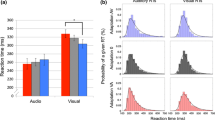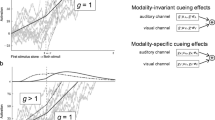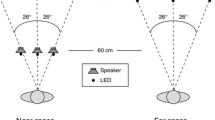Abstract
In natural environments, human sensory systems work in a coordinated and integrated manner to perceive and respond to external events. Previous research has shown that the spatial and temporal relationships of sensory signals are paramount in determining how information is integrated across sensory modalities, but in ecologically plausible settings, these factors are not independent. In the current study, we provide a novel exploration of the impact on behavioral performance for systematic manipulations of the spatial location and temporal synchrony of a visual-auditory stimulus pair. Simple auditory and visual stimuli were presented across a range of spatial locations and stimulus onset asynchronies (SOAs), and participants performed both a spatial localization and simultaneity judgment task. Response times in localizing paired visual-auditory stimuli were slower in the periphery and at larger SOAs, but most importantly, an interaction was found between the two factors, in which the effect of SOA was greater in peripheral as opposed to central locations. Simultaneity judgments also revealed a novel interaction between space and time: individuals were more likely to judge stimuli as synchronous when occurring in the periphery at large SOAs. The results of this study provide novel insights into (a) how the speed of spatial localization of an audiovisual stimulus is affected by location and temporal coincidence and the interaction between these two factors and (b) how the location of a multisensory stimulus impacts judgments concerning the temporal relationship of the paired stimuli. These findings provide strong evidence for a complex interdependency between spatial location and temporal structure in determining the ultimate behavioral and perceptual outcome associated with a paired multisensory (i.e., visual-auditory) stimulus.







Similar content being viewed by others
References
Blauert J (1997) Spatial hearing: the psychophysics of human sound localization. MIT Press, Cambridge
Carriere BN, Royal DW, Wallace MT (2008) Spatial heterogeneity of cortical receptive fields and its impact on multisensory interactions. J Neurophysiol 99(5):2357–2368. doi:10.1152/jn.01386.2007
Colavita F (1974) Human sensory dominance. Atten Percept Psychophys 16(2):409–412. doi:10.3758/bf03203962
Colonius H, Diederich A (2006) The race model inequality: interpreting a geometric measure of the amount of violation. Psychol Rev 113(1):148–154. doi:10.1037/0033-295X.113.1.148
Conrey BL, Pisoni DB (2004) Detection of auditory-visual asynchrony in speech and nonspeech signals. Research on Spoken Language Processing, vol 26. Indiana University, Bloomington
Conrey B, Pisoni DB (2006) Auditory-visual speech perception and synchrony detection for speech and nonspeech signals. J Acoust Soc Am 119(6):4065–4073
Corey DP, Hudspeth AJ (1979) Response latency of vertebrate hair cells. Biophys J 26(3):499–506. doi:10.1016/S0006-3495(79)85267-4
Diederich A, Colonius H (2004) Bimodal and trimodal multisensory enhancement: effects of stimulus onset and intensity on reaction time. Percept Psychophys 66(8):1388–1404
Diederich A, Colonius H (2008) When a high-intensity “distractor” is better then a low-intensity one: modeling the effect of an auditory or tactile nontarget stimulus on visual saccadic reaction time. Brain Res 1242:219–230. doi:10.1016/j.brainres.2008.05.081
Dixon NF, Spitz L (1980) The detection of auditory visual desynchrony. Perception 9(6):719–721
Foss-Feig JH, Kwakye LD, Cascio CJ, Burnette CP, Kadivar H, Stone WL, Wallace MT (2010) An extended multisensory temporal binding window in autism spectrum disorders. Exp Brain Res 203(2):381–389. doi:10.1007/s00221-010-2240-4
Hairston WD, Laurienti PJ, Mishra G, Burdette JH, Wallace MT (2003) Multisensory enhancement of localization under conditions of induced myopia. Exp Brain Res 152(3):404–408
Hecht D, Reiner M, Karni A (2008) Multisensory enhancement: gains in choice and in simple response times. Exp Brain Res 189(2):133–143. doi:10.1007/s00221-008-1410-0
Hershenson M (1962) Reaction time as a measure of intersensory facilitation. J Exp Psychol 63:289–293
Hillock AR, Powers AR, Wallace MT (2011) Binding of sights and sounds: age-related changes in multisensory temporal processing. Neuropsychologia 49(3):461–467. doi:10.1016/j.neuropsychologia.2010.11.041
Hirsh IJ, Sherrick CE Jr (1961) Perceived order in different sense modalities. J Exp Psychol 62:423–432
Keetels M, Vroomen J (2005) The role of spatial disparity and hemifields in audio-visual temporal order judgments. Exp Brain Res 167(4):635–640. doi:10.1007/s00221-005-0067-1
Kim S, James TW (2010) Enhanced effectiveness in visuo-haptic object-selective brain regions with increasing stimulus salience. Hum Brain Mapp 31(5):678–693. doi:10.1002/hbm.20897
Kim S, Stevenson RA, James TW (in press) Visuo-haptic neuronal convergence demonstrated with an inversely effective pattern of BOLD activation. J Cognit Neurosci. doi:10.1162/jocn_a_00176
King AJ, Palmer AR (1985) Integration of visual and auditory information in bimodal neurones in the guinea-pig superior colliculus. Exp Brain Res 60(3):492–500
Krueger J, Royal DW, Fister MC, Wallace MT (2009) Spatial receptive field organization of multisensory neurons and its impact on multisensory interactions. Hear Res 258(1–2):47–54. doi:10.1016/j.heares.2009.08.003
Lamb TD, Pugh EN Jr (1992) A quantitative account of the activation steps involved in phototransduction in amphibian photoreceptors. J Physiol 449:719–758
Lennie P (1981) The physiological basis of variations in visual latency. Vision Res 21(6):815–824
Lewald J, Guski R (2003) Cross-modal perceptual integration of spatially and temporally disparate auditory and visual stimuli. Brain Res Cogn Brain Res 16(3):468–478
Lewald J, Guski R (2004) Auditory-visual temporal integration as a function of distance: no compensation for sound-transmission time in human perception. Neurosci Lett 357(2):119–122. doi:10.1016/j.neulet.2003.12.045
Lovelace CT, Stein BE, Wallace MT (2003) An irrelevant light enhances auditory detection in humans: a psychophysical analysis of multisensory integration in stimulus detection. Brain Res Cogn Brain Res 17(2):447–453
Macaluso E, George N, Dolan R, Spence C, Driver J (2004) Spatial and temporal factors during processing of audiovisual speech: a PET study. NeuroImage 21(2):725–732
Matin L (1986) Visual localization and eye movements. In: Boff KR, Kaufman L, Thomas JP (eds) Handbook of perception and human performance, vol 1. Wiley-Interscience, New York, pp 20.21–20.45
McGurk H, MacDonald J (1976) Hearing lips and seeing voices. Nature 264(5588):746–748
Meredith MA, Stein BE (1986a) Spatial factors determine the activity of multisensory neurons in cat superior colliculus. Brain Res 365(2):350–354
Meredith MA, Stein BE (1986b) Visual, auditory, and somatosensory convergence on cells in superior colliculus results in multisensory integration. J Neurophysiol 56(3):640–662
Meredith MA, Nemitz JW, Stein BE (1987) Determinants of multisensory integration in superior colliculus neurons. I. Temporal factors. J Neurosci 7(10):3215–3229
Meredith MA, Wallace MT, Stein BE (1992) Visual, auditory and somatosensory convergence in output neurons of the cat superior colliculus: multisensory properties of the tecto-reticulo-spinal projection. Exp Brain Res 88(1):181–186
Miller J (1982) Divided attention: evidence for coactivation with redundant signals. Cogn Psychol 14(2):247–279
Miller LM, D’Esposito M (2005) Perceptual fusion and stimulus coincidence in the cross-modal integration of speech. J Neurosci 25(25):5884–5893
Nelson WT, Hettinger LJ, Cunningham JA, Brickman BJ, Haas MW, McKinley RL (1998) Effects of localized auditory information on visual target detection performance using a helmet-mounted display. Hum Factors 40(3):452–460
Nordlund B (1962) Physical factors in angular localization. Acta Otolaryngol 54:75–93
Pöppel E, Schill K, von Steinbüchel N (1990) Sensory integration within temporally neutral systems states: a hypothesis. Naturwissenschaften 77:89–91
Powers AR III, Hillock AR, Wallace MT (2009) Perceptual training narrows the temporal window of multisensory binding. J Neurosci 29(39):12265–12274. doi:10.1523/JNEUROSCI.3501-09.2009
Raab DH (1962) Statistical facilitation of simple reaction times. Trans NY Acad Sci 24:574–590
Roach NW, Heron J, Whitaker D, McGraw PV (2011) Asynchrony adaption reveals neural population code for audio-visual timing. Proc R Soc 278:9
Ross LA, Saint-Amour D, Leavitt VM, Javitt DC, Foxe JJ (2007a) Do you see what I am saying? Exploring visual enhancement of speech comprehension in noisy environments. Cereb Cortex 17(5):1147–1153. doi:10.1093/cercor/bhl024
Ross LA, Saint-Amour D, Leavitt VM, Molholm S, Javitt DC, Foxe JJ (2007b) Impaired multisensory processing in schizophrenia: deficits in the visual enhancement of speech comprehension under noisy environmental conditions. Schizophr Res 97(1–3):173–183. doi:10.1016/j.schres.2007.08.008
Royal DW, Carriere BN, Wallace MT (2009) Spatiotemporal architecture of cortical receptive fields and its impact on multisensory interactions. Exp Brain Res 198(2–3):127–136. doi:10.1007/s00221-009-1772-y
Schall S, Quigley C, Onat S, Konig P (2009) Visual stimulus locking of EEG is modulated by temporal congruency of auditory stimuli. Exp Brain Res 198(2–3):137–151. doi:10.1007/s00221-009-1867-5
Seitz AR Sr, Nanez JE, Holloway SR, Watanabe T (2006) Perceptual learning of motion leads to faster flicker perception. PLoS ONE 1(1):e28. doi:10.1371/journal.pone.0000028
Senkowski D, Talsma D, Grigutsch M, Herrmann CS, Woldorff MG (2007) Good times for multisensory integration: effects of the precision of temporal synchrony as revealed by gamma-band oscillations. Neuropsychologia 45(3):561–571
Shams L, Kamitani Y, Shimojo S (2000) Illusions. What you see is what you hear. Nature 408(6814):788
Stein BE, Wallace MT (1996) Comparisons of cross-modality integration in midbrain and cortex. Prog Brain Res 112:289–299
Stein BE, Huneycutt WS, Meredith MA (1988) Neurons and behavior: the same rules of multisensory integration apply. Brain Res 448(2):355–358
Stevenson RA, James TW (2009) Audiovisual integration in human superior temporal sulcus: inverse effectiveness and the neural processing of speech and object recognition. NeuroImage 44(3):1210–1223. doi:10.1016/j.neuroimage.2008.09.034
Stevenson RA, Geoghegan ML, James TW (2007) Superadditive BOLD activation in superior temporal sulcus with threshold non-speech objects. Exp Brain Res 179(1):85–95
Stevenson RA, Kim S, James TW (2009) An additive-factors design to disambiguate neuronal and areal convergence: measuring multisensory interactions between audio, visual, and haptic sensory streams using fMRI. Exp Brain Res 198(2–3):183–194. doi:10.1007/s00221-009-1783-8
Stevenson RA, Altieri NA, Kim S, Pisoni DB, James TW (2010) Neural processing of asynchronous audiovisual speech perception. NeuroImage 49(4):3308–3318. doi:10.1016/j.neuroimage.2009.12.001
Stevenson RA, VanDerKlok RM, Pisoni DB, James TW (2011) Discrete neural substrates underlie complementary audiovisual speech integration processes. NeuroImage 55(3):1339–1345. doi:10.1016/j.neuroimage.2010.12.063
Sugita Y, Suzuki Y (2003) Audiovisual perception: implicit estimation of sound-arrival time. Nature 421(6926):911. doi:10.1038/421911a
Talsma D, Senkowski D, Woldorff MG (2009) Intermodal attention affects the processing of the temporal alignment of audiovisual stimuli. Exp Brain Res 198(2–3):313–328. doi:10.1007/s00221-009-1858-6
van Atteveldt NM, Formisano E, Blomert L, Goebel R (2007) The effect of temporal asynchrony on the multisensory integration of letters and speech sounds. Cereb Cortex 17(4):962–974. doi:10.1093/cercor/bhl007
van Wassenhove V, Grant KW, Poeppel D (2007) Temporal window of integration in auditory-visual speech perception. Neuropsychologia 45(3):598–607. doi:10.1016/j.neuropsychologia.2006.01.001
Vatakis A, Spence C (2006) Audiovisual synchrony perception for music, speech, and object actions. Brain Res 1111(1):134–142. doi:10.1016/j.brainres.2006.05.078
Vroomen J, Keetels M (2010) Perception of intersensory synchrony: a tutorial review. Atten Percept Psychophys 72(4):871–884. doi:10.3758/APP.72.4.871
Wallace MH, Murray MM (eds) (2011) Frontiers in the neural basis of multisensory processes. Taylor & Francis, London
Wallace MT, Meredith MA, Stein BE (1992) Integration of multiple sensory modalities in cat cortex. Exp Brain Res 91(3):484–488
Wallace MT, Roberson GE, Hairston WD, Stein BE, Vaughan JW, Schirillo JA (2004) Unifying multisensory signals across time and space. Exp Brain Res 158(2):252–258. doi:10.1007/s00221-004-1899-9
Wilkinson LK, Meredith MA, Stein BE (1996) The role of anterior ectosylvian cortex in cross-modality orientation and approach behavior. Exp Brain Res 112(1):1–10
Zampini M, Shore DI, Spence C (2003) Audiovisual temporal order judgments. Exp Brain Res 152(2):198–210. doi:10.1007/s00221-003-1536-z
Zampini M, Guest S, Shore DI, Spence C (2005a) Audio-visual simultaneity judgments. Percept Psychophys 67(3):531–544
Zampini M, Shore DI, Spence C (2005b) Audiovisual prior entry. Neurosci Lett 381(3):217–222. doi:10.1016/j.neulet.2005.01.085
Acknowledgments
This research was funded in part through a grant from NIDCD awarded to Mark Wallace and Stephen Camarata, NIH # R34 DC010927, as well as an NIDCD grant awarded to Ryan Stevenson, NIH 1F32 DC011993. We would also like to acknowledge the support of the Vanderbilt Kennedy Center and the Vanderbilt Brain Institute.
Author information
Authors and Affiliations
Corresponding author
Electronic supplementary material
Below is the link to the electronic supplementary material.
Rights and permissions
About this article
Cite this article
Stevenson, R.A., Fister, J.K., Barnett, Z.P. et al. Interactions between the spatial and temporal stimulus factors that influence multisensory integration in human performance. Exp Brain Res 219, 121–137 (2012). https://doi.org/10.1007/s00221-012-3072-1
Received:
Accepted:
Published:
Issue Date:
DOI: https://doi.org/10.1007/s00221-012-3072-1




